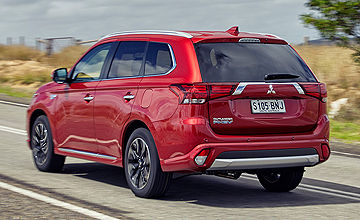BY TIM ROBSON | 6th Apr 2017

Just 305,000 plug-in hybrids were sold in 2016, for example, against a global pool of more than 88 million cars and LCVs sold.
The numbers are steadily on the rise, and Mitsubishi reckons the Outlander PHEV has not only grabbed about 16 per cent of all worldwide PHEV sales since its launch in 2012, but its real-world demeanour stands it in good stead to grab more.
“Since we've launched PHEV in 2014, we've sold over 6800 units total,” said Mitsubishi Motors Australia Limited (MMAL)’s head of product planning, James Lot. “It’s quite an achievement and makes it the leading EV type vehicle in our marketplace. What's PHEV all about for us? Well, it's the worlds first plug in hybrid SUV and that's really the key to this product.”In essence, the Outlander PHEV doesn’t want to be seen as a lentil-chewing, sackcloth-wearing planet saver. Cloaked in the garb of a medium SUV, it goes about its job with no one any the wiser that two electric motors are whirring away at either end of the car.
It also uses the knowledge that Mitsubishi has gleaned over the years from not just electric tech in the iMiev, but its all-wheel-drive tech and even its anti-yaw stability control pinched from the Evo.
It’s a pretty clever piece of kit that can operate as a pure electric vehicle for a claimed 54km, as a series hybrid (where the 2.0-litre four-cylinder petrol engine acts only as a generator to charge the battery array) and as a parallel hybrid (where the petrol motor adds motive force to the two electric motors) – and it does it all seamlessly and effortlessly.
The push-button starter heralds only a beep and a dash message, with the EV mode taking priority at parking lot speeds. Mitsubishi says it has built an audible whir into the system to alert pedestrians, but it’s still quiet enough to creep up behind an inattentive jaywalker without them noticing.
New for the 2017 version of the Outlander is a button that allows the driver to lock the car into EV mode, as long as the battery holds sufficient charge. It’ll remain in play up to 120km/h, or if the throttle is kicked down quickly enough to tell the car more oomph is needed right away.
It works well, too, with sub-50km/h urban areas tackled with ease. The response from the 60kW electric motors is instant and strong, too.
In twistier country terrain, the Outlander does show its downside – with a 1860kg kerb weight it’s 325kg heavier than a petrol AWD Outlander, and the battery mass that’s mounted between the axles and under the floor does have an affect on handling.
The weight of the pack is mounted low in the car and helps to settle the ride, and revisions to spring and damper rates have yielded a brilliant ride quality at low speeds and on smooth terrain. Over rippled or broken surfaces, though, the Outlander doesn’t settle quickly enough, which can upset the occupants.
Adding to that feeling is the otherwise excellent adjustable regenerative braking system, controlled by paddles behind the wheel that would otherwise be used as shifters in a normal car. By adding a degree of extra resistance to the system up to a level of five, it’s possible to add charge more quickly back into the battery, but at the expense of quite heavy deceleration moments at low to medium speeds.
It’s akin to a cabbie who constantly taps the brakes lightly on the long ride to the airport by the end of the trip, you feel quite unsettled.
This is all part of the learning curve of driving the PHEV, though it’s both very similar and very different to what you’re used to driving. Adding kilometres of charge back into the battery gauge, for example, or trying to add extra ‘leaves’ to your economical driving ‘tree’, quickly become quite addictive, and your driving style adapts to the new environment.
Equally, if you want to get in, press start and just drive, the Outlander will do that too, with zero intrusion. A caveat about the claimed 1.7 litres per 100km fuel economy figure, though… it’s almost impossible to achieve in the real world, if your real world extends past anything more than short urban trips on battery power.
Over a 240km run in city and country areas, we returned a figure more like 7.5L/100km, draining the battery from full before using the petrol engine to add about 20km of range back to it.
Using the petrol engine to generate electricity for the battery is the main reason for the high test figure, but it’s wise to go into this with the thought that while 1.7L/100km sounds brilliant, it won’t be a number that gets hit every day, unless you have a short commute to work and are charging it at both work and home.
Given that most medium SUVs will spend their lives trundling around at low to medium speeds in urban environments, the Outlander PHEV’s optimum operating window is right on the money. It’ll serve very well as a short-range EV, especially with regular battery top-ups, and the petrol engine will calm any range anxiety fears.
It’s not as well suited to longer distance touring, though with careful driving you can still eke out over 500km on a tank and a charge. The limited range and its ride at higher speeds on rougher roads is a factor to consider.
On balance, though, the Outlander PHEV is an important car it shows it’s possible to build electric-centric cars for everyday use that don’t look like science experiments. The relatively high price of entry will naturally limit sales, but the second-generation Outlander PHEV will fare better than the first.